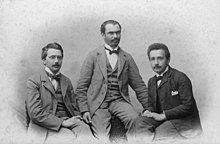Conrad Habicht
Conrad Habicht (born December 28, 1876 in Schaffhausen ; † October 23, 1958 there ) was a Swiss teacher of mathematics and physics, who became known through his friendship with Albert Einstein .
Life
Conrad Habicht was born as the son of the businessman Johann Conrad Habicht and Susanna Elisabetha. Oechslin was born in Schaffhausen in 1876. From 1896 to 1897 he studied philosophy at the University of Zurich , then mathematics and physics at the Eidgenössisches Polytechnikum Zurich . He then studied in Munich and Berlin until 1901 . In 1903 the doctorate at the University of Bern followed . From 1904 Habicht was a teacher of mathematics and physics at the Protestant college in Schiers and from 1915 to 1948 teacher at the canton school in Schaffhausen .
Habicht had already met Einstein in Schaffhausen. Between 1901 and 1904 Albert Einstein, Maurice Solovine and Conrad Habicht met for evening sessions, which they called the Olympia Academy . The meetings ended after Habicht left Bern in 1904 and Solovine in 1905. The three interlocutors remained in friendly contact for life.
It was Habicht to whom Einstein announced four of his most important works in May 1905:
- The first work deals with radiation and the energetic properties of light (the light quantum hypothesis )
- The second work is a determination of the true atom size from diffusion and internal friction. (Einstein's doctoral thesis)
- The third proves that, assuming the molecular theory of heat, bodies suspended in liquids [...] must perform a perceptible, disordered movement (via Brownian movement )
- The fourth [...] is an electrodynamics of moving bodies using a modification of the theory of space and time. (the special theory of relativity )
From 1907 to 1909 Conrad Habicht worked together with his brother Paul, an engineer, on a device for measuring very small amounts of electrical energy, the electrostatic potential multiplier . Einstein had hoped for a lot from the device, which was patented under the name Habicht-Einstein. The "Maschinchen" was not a commercial success.
Private
Habicht married Anna Margaretha Kehlstadt, a teacher from Basel, in 1913. From 1935 to 1958 he was director of the «Musik-Collegium Schaffhausen» and was considered a virtuoso violin player.
literature
- Jürgen Neffe: Einstein. A biography . Rowohlt, Reinbek near Hamburg 2006
- Maurice Solovine: Friendship with Albert Einstein . In: Physical sheets . 15 (1959), 3, pp. 97-103
- Albert Einstein: A new electrostatic method for measuring the smallest amounts of electricity . In: Physikalische Zeitschrift . 7 (1908), pp. 216-217
Web links
- Hans-Josef Küpper: Academy Olympia , at Einstein.de
- Thomas Franz Schneider: Habicht, Conrad. In: Historical Lexicon of Switzerland .
- The miracle of Bern . In: Der Spiegel . No. 3 , 2005 ( online ).
| personal data | |
|---|---|
| SURNAME | Hawk, Conrad |
| BRIEF DESCRIPTION | Swiss teacher for mathematics and physics and member of the Olympia Academy |
| DATE OF BIRTH | December 28, 1876 |
| PLACE OF BIRTH | Schaffhausen |
| DATE OF DEATH | October 23, 1958 |
| Place of death | Schaffhausen |
